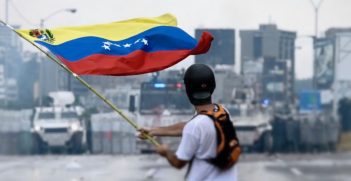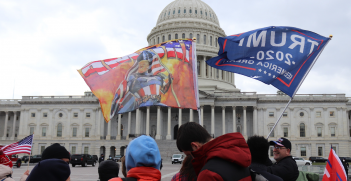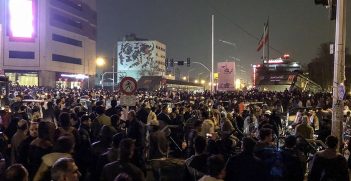(Old) Challenges and (New?) Crises in Latin America

Recent civil unrest across Latin America is a result of institutional flaws which have consistently plagued the region. This could lead to long-term instability and even the erosion of democracy.
In the past month, there have been several major political crises in Latin America that have hit the news. The constitutional crisis between Perú’s President Martín Vizcarra and the opposition-dominated Congress and now the controversial re-election of Evo Morales in Bolivia have all created political instability in the region. Civil unrest related to the costs of living has manifested in widespread protests against President Lenín Moreno in Ecuador organised by indigenous movements and political opponents against rising fuel prices. Similarly, ongoing protests in Chile reflect civilian outrage against the rising price of public transport in Santiago.
All these cases relate to widespread malaises in the region. Since the late 1980s, Latin America as a whole (with the exception of Cuba and, recently, Nicaragua and Venezuela) has overwhelmingly tended to elect its leaders in free and fair elections, embraced the fundamental tenets of liberal democracy, sent the military back to the barracks and developed institutional frameworks that protect these systems. However, several intertwining problems persist that make the region vulnerable to episodes of instability and, in some cases, even democratic backsliding.
Like elephants in the room, these and other problems have refused to go away as major features of political life in the region and should be borne in mind when thinking critically about the recent episodes in question. This laundry list includes:
1 .The lack of effective political representation, with politicians often relying on clientele networks, patronage schemes and corrupt entanglements between the public and private sector to obtain, exercise, and keep power at the expense of the citizens’ needs. This is linked to:
2. The personalist nature of political power, a feature that preceded the advent of democracy in the region and both prevents and is related to the (lack of) development of strong, effective institutional structures and a chronic lack of democratic citizenship;
3. The persistence (and even worsening) of socio-economic inequality, a multifaceted problem that precedes the turn to democracy and the embrace of economic neo-liberalism of two decades ago. However, it remains an endemic problem, even in countries that experienced major episodes of wealth redistribution during the arrival of progressive administrations in the 2000s during the so-called Pint Tide (like Argentina, Brazil, Bolivia, Ecuador and, paradoxically, Venezuela more than anyone else);
4. Inadequate and incapable rule of law systems, including judiciaries, prosecution bodies, law enforcement agents, public defenders and other actors affected by lack of independence, variable levels of professionalisation, mismanagement, corruption and so forth, all of which are largely responsible for the lack of accountability, a culture of impunity, and the criminal penetration of state and society across the region, and;
5. The vulnerability to global economic cycles and commodity booms, a longstanding problem that has also not been overcome in the neoliberal era or properly addressed otherwise. Of course, these (and other) problems should also be considered together with major positive developments in the past decades. Yet, they remain challenges with the potential to overturn some of these achievements and bring back problems that we thought had been overcome.
This takes us back to the four “episodes of crisis” that we witnessed in the past few days in the region. All of them, one way or another, can be traced back to one (or more) of the key challenges highlighted above.
In the Peruvian case, the shocking conflict between the executive and legislative branches hides deeper problems related to the fight against corruption and the persistent obstructionism of Fujimori’s political dynasty. In a country where a large portion of its political class is discredited, these pose the most significant challenges to democracy in Peru for almost three decades (including their attempt to control the Constitutional Court). Yet, the crisis seems sorted for the time being – with Congress closed and legislative elections on the way, President Vizcarra has the backing of the military and the popular support of the people.
In Ecuador, mass protests and clashes between security forces and demonstrators led to a triumph for indigenous groups. The President agreed to restore subsidies on petrol and suspending austerity measures which had previously been passed without popular support and proper consultation. However, there are still major concerns. On one hand, the agreement that solved the conflict between the government and indigenous groups has been seen (at least by some analysts) as a partial victory, as not all austerity measures were withdrawn. Additionally, although ex-President Rafael Correa and his allies backed the protests, their involvement and participation was controversial and not embraced by indigenous groups (which had major confrontations with Correa during his government). On the other hand, using military force to confront protesters is a major (and worrying) development of its own. Trusting the military to restore order and as a symbolic force is risky for the military and the regime’s legitimacy as a whole.
But perhaps the most significant of the three crises is Chile’s – one of the region’s most stable democracies and often seen as a country that has largely dodged other problems that affect the rest of the region. But in some respects, it evidently has not. Persistent economic inequality in Chile is a problem that has been diagnosed and discussed by analysts for years, as has the increasing frustration of the population with a political class that fails to acknowledge and embrace the need for reform. Moreover, although the military refused to endorse embattled President Piñera’s description of the conflict as ‘war’, the death toll, high number of injured citizens and significant allegations of human rights violations by security forces are extremely concerning. In the aftermath of the riots, protests and ensuing repression, Piñera has emerged as an ever-unpopular President. He faces a massive political movement with demands that seem to go well beyond the President’s efforts and concessions to solve the crisis.
By highlighting common problems, I do not seek to perpetuate simplistic and/or stereotypical tropes about Latin America or do away with the need to carefully and rigorously evaluate each of the crises on their own right, beyond facile ideological postures. But it is important to keep a comparative perspective on these issues and look at the bigger picture of the broader problems they relate to. Moreover, most of them are also present in other weakly-institutionalised democracies and even in established liberal-democratic polities, several of which are experiencing the rise of populist leaders and movements. As has been in the past, the region’s episodes of political instability are also manifestations of broader global trends and, unfortunately, we are living in an era where democracy is no longer “the only game in town” (if it ever was).
Dr Raul Sanchez Urribari is a Senior Lecturer in Crime, Justice and Legal Studies at La Trobe University, Melbourne.
This article is published under a Creative Commons Licence and may be republished with attribution.





